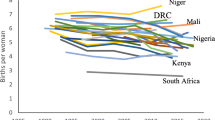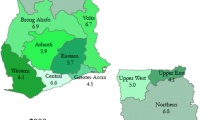Abstract
The rationing of births in China after the 1979 announcement of the “one-child family policy” has been held responsible for the rapid decrease in Chinese fertility, whereas other observers have noted that parallel fertility declines occurred with voluntary behavior in other East and Southeast Asian countries. This paper assesses the joint contribution of local family planning and health programs, individual characteristics of women, and the development of their communities, as explanatory variables for Chinese fertility in rural areas of three provinces in 1985. Given the explicit quantitative reproductive goals of the government, an ordered Probit model for cumulative fertility is estimated for women age 15–34 and 35–49.
Similar content being viewed by others
References
Bannister J (1987) China's changing population. Stanford University Press, Stanford, CA
Becker GS (1965) A theory of the allocation of time. Econ J 75 (299):493–517
Birdsall N, Jamison DT (1983) Income and other factors influencing fertility in China. Popul Dev Rev 9 (4):651–675
Coale AJ (1984) Rapid population change in China, 1952–1982. Committee on population and demography, report No 27. National Academy Press, Washington, DC
Feeney G, Wang F, Zhou M, Xiao B (1989) Recent fertility dynamics in China: Results from the 1987 one percent population survey. Popul Dev Rev 15 (2):297–322
Greenhalgh S, Zhu C, Li N (1994) Restraining population growth in three Chinese villages 1988–1993. Popul Dev Rev 20 (2):365–395
Hardee-Cleveland KA, Banister J (1988) Fertility policy and implementation in China. Popul Dev Rev 14 (2):245–286
Johnson DG (1990) The people's republic of China, 1978–1990. ICEG series of country studies, No 8, ICS Press, San Francisco, CA
Johnson DG (1994) Effects of institutions and policies on rural population growth: The case of China. Popul Dev Rev 20 (3):503–531
Lin JL (1987) Household farm, cooperative farm and efficiency: Evidence from rural de-collectivization in China. Economic Growth Center Discussion Paper No 533, Yale University, New Haven, CT
Lin JL (1988) The household responsibility system in China's agricultural reform: A theoretical and empirical study. Econ Dev Cultural Change 36 (6) (Suppl):S199-S224
Luther NY, Feeney G, Zhang WM (1990) One-child families or baby boom? Evidence from China's one-per-hundred survey. Popul Studies 44 (2):341–357
Maddala GS (1983) Limited-dependent and qualitative variables in econometrics. Cambridge University Press, Cambridge
Parish WL (1985) ’Introduction: Historical background and current issues‘. In: Parish WL (ed) Chinese rural development: The great transformation. Sharpe ME, New York
Poston DL, Gu B (1987) Socioeconomic development family planning, and fertility in China. Demography 24 (4):531–551
Rosenzweig MR, Schultz TP (1985) The demand for and supply of births: Fertility and its life cycle consequences. Am Econ Rev 75 (5):992–1015
Schultz TP (1985) Changing world prices, women's wages, and the fertility transition: Sweden, 1860–1910. J Polit Econ 93 (6):1126–1154
Schultz TP (1988) Population programs: Measuring their impact on fertility and the personal distribution of their effects. J Policy Modeling 10 (1):113–149
Schultz TP (1992) Assessing family planning cost-effectiveness. In: Phillips JF, Ross JA (eds) Family planning programmes and fertility. Oxford University Press, New York, pp 78–105
Schultz TP (1994) Marital status and fertility in the United States: Welfare and labor market effects. J Human Resources 29 (2):637–669
Schultz TP (forthcoming) The demand for children in low income countries. In: Rosenzweig M, Stark O (eds) Handbook of population and family economics. North-Holland, Amsterdam
Social Science Academy of China, Population Research Institute (SSAC) (1988) Report and data collections of the national sample survey on migration in 74 cities and towns. Special issue of chinese journal of population science (June 1988)
State Statistical Bureau Department of Population Statistics (SSBDPS) (1986) China in-depth fertility survey (phase 1), principal report, 2 vols. SSBDPS, Beijing
State Statistical Bureau Department of Population Statistics (SSBDPS) (1988) China in-depth fertility survey (phase II), preliminary report. SSBDPS, Beijing
Wang F (1988) The role of individuals' characteristics and the government family planning program in China's fertility decline. Popul Res Policy Rev 7:255–276
Wolf AP (1986) The preeminent role of government interventions in China's family revolution. Popul Dev Rev 12 (1):101–116
Zeng Y (1989) Is the chinese family planning program tightening up? Popul Dev Rev 15 (2):333–337
Zeng Y, Vaupel JW (1989) The impact of urbanization and delayed childbearing on population growth and aging in China. Popul Dev Rev 15 (3):425–445
Zeng Y, Vaupel JW Wang Zh (1994) Marriage and fertility in China: 1950–1989. Genus (forthcoming)
Zhang J (1990a) Socioeconomic determinants of fertility in China. J Popul Econ 3:105–123
Zhang J (1990b) Mortality and fertility: How large is the direct child replacement effect in China. J Popul Econ 3:303–314
Author information
Authors and Affiliations
Additional information
The authors appreciate the comments on and corrections of our paper by John Ermisch and the programming assistance of Paul McGuire. The financial support of the Rockefeller Foundation is acknowledged.
Rights and permissions
About this article
Cite this article
Schultz, T.P., Zeng, Y. Fertility of rural China. Effects of local family planning and health programs. J Popul Econ 8, 329–350 (1995). https://doi.org/10.1007/BF00180872
Received:
Revised:
Issue Date:
DOI: https://doi.org/10.1007/BF00180872




